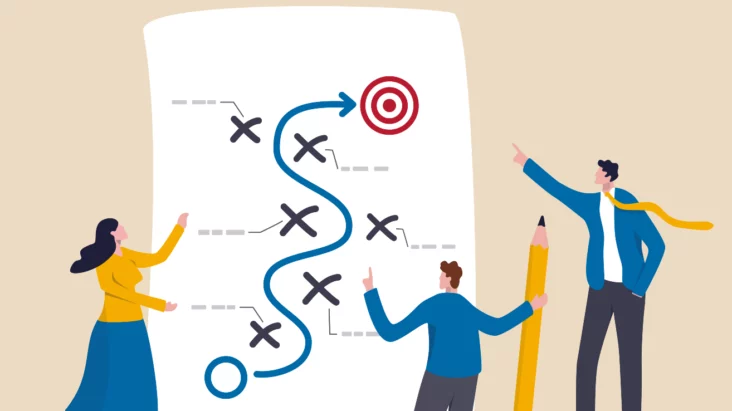In brief:
In the world of Agile product development, ‘spikes’ are an indispensable tool that helps teams navigate uncharted territories and mitigate risks. But what exactly are spikes? How do they fit into the overall development process? And how can we maximise their benefits? In this comprehensive guide, we will delve deep into these questions and more. So buckle up and let’s take a journey through the intriguing world of spikes
Table of content:
Unravelling the Concept of Spikes
In the Agile landscape, a spike is a time-boxed period dedicated to learning and investigation. The term originates from Extreme Programming (XP) and has been widely adopted across various Agile frameworks.
Spikes are used when a team encounters a situation where they lack the necessary information or experience to proceed confidently. This could be anything from understanding the feasibility of a proposed feature, learning how to implement a new technology, or experimenting with different solutions to a complex problem.
The primary goal of a spike is to answer questions or acquire the knowledge necessary to reduce uncertainty and risk. They come in two main types – research spikes and technical spikes. Research spikes focus on gathering information and gaining understanding, while technical spikes involve hands-on experimentation or prototyping.
For instance, if you’re developing a mobile application and want to integrate a new payment gateway, but you’re unsure about its compatibility, you would conduct a spike to explore the integration process, understand the potential challenges, and determine the feasibility.
When to Use Spikes in Agile Product Development
Unlock the Potential of Spikes to Enhance Your Agile Product Development
In Agile development, spikes are used when a team encounters a situation where they lack the necessary information or experience to proceed confidentially. Here are some common scenarios where using spikes can prove beneficial.
Unclear Requirements:
If a user story or feature is not well-defined, or if its implementation is ambiguous, a spike can be used to gather more information and clarify the requirements.
Complex Technical Challenges:
When faced with complex technical issues that the team has not encountered before, conducting a spike helps to explore potential solutions and decide on the best approach.
New Technologies or Tools:
If the team is considering using a new technology or tool, a spike can be performed to evaluate it feasibility, understand its usage, and assess its impact on the project
Estimation difficulties:
When it’s challenging to estimate the time and effort required for a task due to uncertainties, a spike can help provide the necessary insights for more accurate estimations.
Validations of Assumption:
If there are assumptions regarding user experience or functionality that need to be validated, a spike can be conducted to test the hypotheses.
Remember, the goal of a spike is not to deliver a finished piece of work but to gain knowledge or resolve uncertainties that can inform future work. Therefore, it’s important to time-box spikes and focus them on specific questions or challenges. This way, they serve their purpose without diverting too much time and resources from regular development tasks.
Benefits of Using Spike in Agile Product Development
Utilising spikes in Agile product development offers a multitude of benefits. Let’s explore them:
Improved Decision-Making:
Spikes provide valuable insights that inform decision-making. By spending focused time investigating a problem or learning about a new concept, teams can make decisions based on concrete findings and experiences rather than assumptions. This leads to more informed and effective decision-making, enhancing the quality and relevance of the product.
Better Estimation of Tasks:
Estimating tasks in Agile can be challenging, especially when dealing with unfamiliar features or technologies. Spikes help here by providing a deeper understanding of what a task entails and how much effort it might require. With this knowledge, teams can estimate tasks more accurately, leading to better planning and resource allocation.
Reduced Risk and Uncertainty:
Uncertainty and risk are inherent in any product development process. Spikes help reduce these by proactively addressing areas of uncertainty and potential risk. Whether it’s a technical challenge, a new technology, or an unclear requirement, a spike allows the team to explore, learn, and mitigate risks ahead of time.
Enhanced Teamwork and Collaboration:
Spikes often involve cross-functional collaboration, as different team members bring their unique skills and perspectives to solve a problem or investigate a topic. This collaborative approach not only solves immediate challenges but also builds stronger team cohesion. The shared learning experience fosters a culture of knowledge sharing and continuous improvement, which is at the heart of Agile methodologies.
How to Create and Manage Spikes in Agile Product Development
Creating and managing spikes effectively is crucial for reaping their full benefits. Here’s a step-by-step guide on how to do that:
Identifying the Need for a Spike:
The first step towards creating a spike is identifying its need. This could stem from uncertainties in requirements, challenges in estimating tasks, complexities in implementation, or the introduction of new technologies. The goal is to recognize areas where additional knowledge or exploration is required for the team to move forward confidently.
Defining the Scope and Objectives:
Once the need for a spike is identified, the next step is defining its scope and objectives. What are the questions that the spike needs to answer? What uncertainties should it resolve? Clearly articulating these objectives provides direction and focus to the investigation.
Time-Boxing and Resource Allocation:
Spikes should be time-boxed to ensure they don’t overrun and interfere with regular development work. Deciding on a reasonable time frame – often one or two iterations – helps maintain a balance between exploration and product delivery. Additionally, determining which team members will be involved in the spike is essential for effective resource allocation.
Documenting and Sharing Findings:
The value of a spike lies not just in the investigation itself, but also in the insights derived from it. Therefore, documenting findings and sharing them with the entire team is critical. It ensures that the knowledge gained from the spike is accessible to all and can inform future decision-making.
Tips for Maximising the Value of Spikes
Spikes are a powerful tool in Agile product development, but to maximise their value, they need to be used effectively. Here are some tips on how to do that:
Focusing on Specific and Actionable Outcomes:
The goal of a spike should be clear and specific. Instead of trying to explore a broad topic, focus on achieving specific outcomes that can inform your product development process. The more targeted your spike, the more actionable and valuable the results will be.
Encouraging Cross-Functional Collaboration:
Spikes often involve complex issues that require a range of skills and perspectives. Encourage cross-functional collaboration during spikes to leverage the diverse expertise within your team. This collaborative approach can lead to more comprehensive insights and foster a culture of shared learning.
Balancing Spikes with Regular Development Tasks:
While spikes are important, they should not overshadow regular development tasks. Maintain a balance between time spent on spikes and time spent on feature development to ensure that your product continues to progress while you explore and learn.
Reviewing and Learning from Past Spikes:
Don’t let the knowledge gained from a spike be forgotten. Regularly review past spikes and their outcomes. What did you learn? What could you have done differently? This review process helps you refine your approach to future spikes and continuously learn from your experiences.
By following these tips, you can make the most of spikes, turning uncertainties into opportunities for learning and growth. Remember, the key to successful spikes is not just in conducting them, but in how you apply the insights gained to your product development process.
Real-life Examples of Spikes in Action
To understand the practicality and benefits of spikes, let's look at a few real-life examples:
Case Study 1: Addressing a Technical Challenge
Consider a software development team working on a feature that requires integrating their application with a third-party API. However, the team has no prior experience with this particular API, and there is uncertainty about how to implement the integration successfully.
The team decides to create a spike to explore the API, understand its functionality, and test the integration process. They allocate a week for this spike. At the end of the week, they have a clear understanding of the API, have identified potential hurdles in the integration process, and have a plan for implementing the feature. This spike helped them address their technical challenge effectively and proceed with confidence.
Case Study 2: Investigating a New Technology or Tool
Imagine a mobile app development team considering the use of a new cross-platform development tool to improve their productivity and app performance. However, they are unsure whether this tool will be compatible with their current tech stack and meet their specific needs.
They decide to conduct a spike to evaluate this new tool. During the spike, they experiment with the tool, assess its compatibility with their existing tech stack, and evaluate its impact on their workflow and app performance. The insights from this spike help them make an informed decision about whether to adopt the new tool or not.
Case Study 3: Validating a User Experience Assumption
An e-commerce company is planning to redesign their checkout process to reduce cart abandonment rates. They have an assumption that a one-page checkout will improve the user experience and reduce abandonment. However, they are uncertain whether this change will indeed have the desired effect.
The team sets up a spike to validate this assumption. They prototype a one-page checkout process and conduct user testing. The feedback from users helps them validate their assumption and provides valuable insights into how to optimise the checkout process.
These examples illustrate how spikes can be used in different scenarios to tackle uncertainties, explore new technologies, and validate assumptions. By investing time in these focused investigations, Agile teams can ensure they are making informed decisions and effectively managing risks in their product development journey.
In conclusion:
Spikes are an essential tool in Agile product development. They offer an effective way to tackle uncertainties, explore new technologies, validate assumptions, and gain insights that inform better decision-making. By understanding what spikes are, when to use them, and how to manage them effectively, you can turn uncertainties into opportunities for learning and growth.
Remember, the key to successful spikes lies not just in conducting them, but in how you apply the insights gained to your product development process. So, why wait? Start incorporating spikes into your Agile practices today and see how they can enhance your product development journey.
If you found this guide helpful, we encourage you to share it with your colleagues and team members. And if you have any experiences or tips about using spikes in Agile development that you’d like to share, we’d love to hear from you in the comments below!








